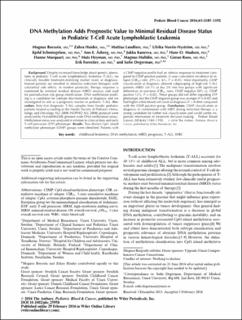| dc.contributor.author | Borssén, Magnus | |
| dc.contributor.author | Haider, Zahra | |
| dc.contributor.author | Landfors, Mattias | |
| dc.contributor.author | Norén-Nyström, Ulrika | |
| dc.contributor.author | Schmiegelow, Kjeld | |
| dc.contributor.author | Åsberg, Ann Elisabeth | |
| dc.contributor.author | Kanerva, Jukka | |
| dc.contributor.author | Madsen, Hans O. | |
| dc.contributor.author | Marquart, Hanne | |
| dc.contributor.author | Heyman, Mats | |
| dc.contributor.author | Hultdin, Magnus | |
| dc.contributor.author | Roos, Göran | |
| dc.contributor.author | Forestier, Erik | |
| dc.contributor.author | Degerman, Sofie | |
| dc.date.accessioned | 2022-11-21T07:56:23Z | |
| dc.date.available | 2022-11-21T07:56:23Z | |
| dc.date.created | 2017-01-10T15:04:02Z | |
| dc.date.issued | 2016 | |
| dc.identifier.citation | Pediatric Blood & Cancer. 2016, 63 (7), 1185-1192. | en_US |
| dc.identifier.issn | 1545-5009 | |
| dc.identifier.uri | https://hdl.handle.net/11250/3033017 | |
| dc.description.abstract | Background. Despite increased knowledge about genetic aberrations in pediatric T-cell acute lymphoblastic leukemia (T-ALL), no clinically feasible treatment-stratifying marker exists at diagnosis. Instead patients are enrolled in intensive induction therapies with substantial side effects. In modern protocols, therapy response is monitored by minimal residual disease (MRD) analysis and used for postinduction risk group stratification. DNA methylation profiling is a candidate for subtype discrimination at diagnosis and we investigated its role as a prognostic marker in pediatric T-ALL.
Procedure. Sixty-five diagnostic T-ALL samples from Nordic pediatric patients treated according to the Nordic Society of Pediatric Hematology and Oncology ALL 2008 (NOPHO ALL 2008) protocol were analyzed by HumMeth450K genome wide DNA methylation arrays. Methylation status was analyzed in relation to clinical data and early T-cell precursor (ETP) phenotype.
Results. Two distinct CpG island methylator phenotype (CIMP) groups were identified. Patients with a CIMP-negative profile had an inferior response to treatment compared to CIMP-positive patients (3-year cumulative incidence of relapse (CIR3y) rate: 29% vs. 6%, P = 0.01). Most importantly, CIMP classification at diagnosis allowed subgrouping of high-risk T-ALL patients (MRD 0.1% at day 29) into two groups with significant differences in outcome (CIR3y rates: CIMP negative 50% vs. CIMP positive 12%; P = 0.02). These groups did not differ regarding ETP phenotype, but the CIMP-negative group was younger (P = 0.02) and had higher white blood cell count at diagnosis (P = 0.004) compared with the CIMP-positive group.
Conclusions. CIMP classification at diagnosis in combination with MRD during induction therapy is a strong candidate for further risk classification and could confer important information in treatment decision making. | en_US |
| dc.language.iso | eng | en_US |
| dc.publisher | Wiley | en_US |
| dc.rights | Navngivelse 4.0 Internasjonal | * |
| dc.rights.uri | http://creativecommons.org/licenses/by/4.0/deed.no | * |
| dc.title | DNA Methylation Adds Prognostic Value to Minimal Residual Disease Status in Pediatric T-Cell Acute Lymphoblastic Leukemia | en_US |
| dc.type | Peer reviewed | en_US |
| dc.type | Journal article | en_US |
| dc.description.version | publishedVersion | en_US |
| dc.source.pagenumber | 1185-1192 | en_US |
| dc.source.volume | 63 | en_US |
| dc.source.journal | Pediatric Blood & Cancer | en_US |
| dc.source.issue | 7 | en_US |
| dc.identifier.doi | 10.1002/pbc.25958 | |
| dc.identifier.cristin | 1424360 | |
| cristin.ispublished | true | |
| cristin.fulltext | original | |
| cristin.qualitycode | 1 | |

